
Despite recent improvements in oral health total edentulism still affects a significant proportion of the population globally. While there have been increases in the use of implant retained prosthesis there remains a need for complete dentures. Techniques taught in dental schools are seen a more complex and time consuming that simplified approached often applied in general practice.
The aim of this review was to compare the efficiency of simplified and traditional methods for the fabrication of complete dentures.
Methods
Searches were conducted in Medline/Pubmed , The Cochrane Library, and ISI Web of Science databases. Randomised controlled trials (RCTs) focused on comparing simplified methods and traditional method of fabricating dentures and published in English were considered. Study selection was carried out by 3 reviewers.
Results
- 6 papers involving 181 patients describing 3 studies were included.
- A narrative summary of the findings was presented.
Conclusions
The authors concluded
Although the studies reviewed demonstrate some advantages of simplified over traditional prostheses, such as lower cost and clinical time, good chewing efficiency, and a positive effect on the quality of life, the reports related the use of different simplified methods for the fabrication of complete dentures. Additional randomized controlled trials that used similar simplified techniques for the fabrication of complete dentures should be performed with larger sample sizes and longer follow-up periods.
Commentary
While the search included a number of databases only those in English were considered which could have excluded some studies. IT is not clear if data abstraction was conducted in duplicate and no study quality assessment is reported. We have previously looked at one of the studies included in this review (Dental Elf 25th Feb 2013), which suggested that a simplified approach helped restore acceptable masticatory function. The other two studies included in this review would seem to support that position. In addition another systematic review (Dental Elf 23rd Jan-2013) which included 5 RCTs looked at different impression techniques for complete dentures and little evidence to support the need for a two stage impression technique for the majority of complete denture cases. Although another trial we reviewed (Dental Elf Jul 10th 2014) suggested a better outcome if silicone was the impression material. However, it should be noted that only a limited number of small trials are available to include within the available reviews and this should be taken into account when considering their findings.
Links
Paulino MR, Alves LR, Gurgel BC, Calderon PS. Simplified versus traditional techniques for complete denture fabrication: A systematic review. J Prosthet Dent. 2014 Oct 10. pii: S0022-3913(14)00388-6. doi: 10.1016/j.prosdent.2014.08.004. [Epub ahead of print] PubMed PMID: 25311792

[…] Dental Elf -23rd Oct 2014 – Compete dentures: no difference between simplified and traditional… […]
[…] Compete dentures: no difference between simplified and traditional approaches to fabrication […]